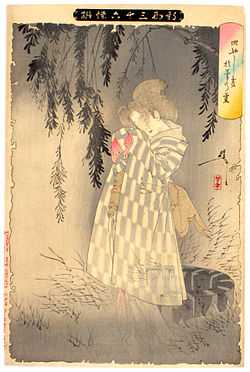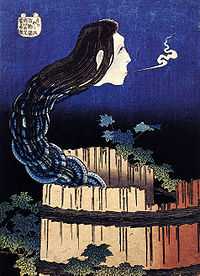Banchō Sarayashiki

Banchō Sarayashiki or Bancho Sarayashi[citation needed] (番町皿屋敷 The Dish Mansion at Banchō) is a Japanese ghost story of love separated by social class, broken trust and broken promises, leading to a dismal fate.
The story of Okiku and the Nine Plates is one of the most famous in Japanese folklore, and continues to resonate with audiences today.
History
The story of Okiku is an old one, whose true origins are unknown; however, it first appeared under the title Bancho Sarayashiki in July 1741 at the Toyotakeza theater. The familiar ghost legend had been adapted into a ningyō jōruri production by Asada Iccho and Tamenaga Tarobei I. Like many successful puppet shows, a Kabuki version followed and in September 1824, Banchō Sarayashiki was staged at the Naka no Shibai theater starring Otani Tomoemon II and Arashi Koroku IV in the roles of Aoyama Daihachi and Okiku.
A one-act Kabuki version was created in 1850 by Segawa Joko III, under the title Minoriyoshi Kogane no Kikuzuki, which debuted at the Nakamura-za theater and starred Ichikawa Danjūrō VIII and Ichikawa Kodanji IV in the roles of Tetsuzan and Okiku. This one-act adaptation was not popular, and quickly folded, until it was revived in June 1971 at the Shimbashi Embujō theater, starring the popular combination of Kataoka Takao and Bando Tamasaburō V in the roles of Tetsuzan and Okiku.
The most familiar and popular adaptation of Banchō Sarayashiki, written by Okamoto Kido, debuted in February 1916 at the Hongō-za theater, starring Ichikawa Sadanji II and Ichikawa Shōchō II in the roles of Lord Harima and Okiku. It was a modern version of the classic ghost story in which the horror tale was replaced by a deep psychological study of the two characters' motivations.
Another adaptation was made in 2002, in Story 4 of the Japanese television drama Kaidan Hyaku Shosetsu.[1]
Plot summary
Folk version
Once there was a beautiful servant named Okiku. She worked for the samurai Aoyama Tessan. Okiku often refused his amorous advances, so he tricked her into believing that she had carelessly lost one of the family's ten precious delft plates. Such a crime would normally result in her death. In a frenzy, she counted and recounted the nine plates many times. However, she could not find the tenth and went to Aoyama in guilty tears. The samurai offered to overlook the matter if she finally became his lover, but again she refused. Enraged, Aoyama threw her down a well to her death.
It is said that Okiku became a vengeful spirit (Onriyō) who tormented her murderer by counting to nine and then making a terrible shriek to represent the missing tenth plate – or perhaps she had tormented herself and was still trying to find the tenth plate but cried out in agony when she never could. In some versions of the story, this torment continued until an exorcist or neighbor shouted "ten" in a loud voice at the end of her count. Her ghost, finally relieved that someone had found the plate for her, haunted the samurai no more.
Ningyō Jōruri version
Hosokawa Katsumoto, the lord of Himeji Castle, has fallen seriously ill. Katsumoto's heir, Tomonosuke, plans to give a set of 10 precious plates to the Shogun to ensure his succession. However, chief retainer Asayama Tetsuzan plots to take over. Tomonosuke's retainer, Funase Sampei Taketsune is engaged to marry a lady in waiting, Okiku. Tetsuzan plans to force Okiku to help him murder Tomonosuke.
Tetsuzan, through the help of a spy, steals one of the 10 plates and summons Okiku to bring the box containing the plates to his chamber. There, he attempts to seduce Okiku. She refuses due to her love for Taketsune. Rejected, Tetsuzan then has Okiku count the plates to find only nine. He blames her for the theft and offers to lie for her if she will be his mistress. Okiku again refuses and Tetsuzan has her beaten with a wooden sword.
Tetsuzan then has her suspended over a well and, erotically enjoying her torture, has her lowered into the well several times, beating her himself when she is raised. He demands that she become his lover and assist in the murder of Tomonosuke. She refuses again, whereupon Tetsuzan strikes her with his sword, sending her body into the well.
While wiping clean his sword, the sound of a voice counting plates comes from the well. Tetsuzan realizes that it is the ghost of Okiku but is entirely unmoved. The play ends with the ghost of Okiku rising from the well, Tetsuzan staring at her contemptuously.
Okamoto Kido version
In 1655, in Edo, a vassal of the Shogun Aoyama Harima has fallen in love with a young servant girl Okiku. Aoyama has promised to marry her, but has recently received an auspicious marriage proposal from an Aunt. Aoyama promises Okiku that he will honor their love, and refuse the proposal.
Okiku doubts, and tests him by breaking one of the 10 heirloom plates that are the treasure of the Aoyama household. The traditional punishment for breaking one of the plates is death, which is demanded by Aoyama's family.
At first, Aoyama is convinced that Okiku broke the plate by accident, and pardons her, but when Okiku reveals that she broke the plate as a love-test, Aoyama is enraged and kills her. He then throws her body down a well.
From then after, Okiku’s ghost is seen to enter the house and count the plates, one through nine. Encountering her in the garden, Aoyama sees that her ghostly face is not one of vengeance, but beauty and calm. Taking strength from this, he commits seppuku and joins her in death.
Romantic Influence
Okamoto's version is notable for being a much more romantic adaptation of the story, similar to the Kabuki version of Botan Doro. This was an influence of the Meiji restoration, which brought Western plays to Japan for the first time. Western plays were much more noticeable for romantic elements, and this was adapted into a style of theater known as Shin Kabuki. Shin Kabuki was ultimately an unsuccessful merger of East and West, although Okamoto's Bancho Sarayashiki remains as one of the few classics.
Okiku and Ukiyo-e
Like many Kabuki plays, Okiku was a popular subject matter for ukiyo-e artists. In 1830, Katsushika Hokusai included her as one of the kaidan in his One Hundred Tales (Hyaku monogatari) series. Ekin, a somewhat notorious artist who had troubles with the law, painted a Byobu-e [2] of Okiku being accused by Tetsuzan Aoyama and his brother Chuta.
Most notably, she appeared as one of the New Forms of Thirty-Six Ghosts by Tsukioka Yoshitoshi. His portrayal of Okiku is unusually sympathetic, particularly as ghosts were viewed as fearsome apparitions by nineteenth-century Japanese, reflecting a general trend in his later work.
Influences on Japanese culture
In 1795, old wells in Japan suffered from an infestation of a type of worm that became known as the "Okiku bug" (Okiku mushi). This worm, covered with thin threads making it look as though it had been bound, was widely believed to be a reincarnation of Okiku.
The Ningyo Joruri version is set in Himeji Castle, a popular tourist attraction at the castle is Okiku-Ido, or Okiku's Well. Traditionally, this is where the hapless maid's body was thrown after being killed by Tetsuzan. Although the castle is closed at night, it is said that her ghost still rises nightly from the well, and counts to nine before shrieking and returning.
The NES game Monster Party features a boss named "The haunted well", a well who attacks by throwing plates at the player, a reference to the tale. But since the game was only released in the USA, many players did not understand the concept.[3]
Manga artist Rumiko Takahashi included a parody of the legend of Okiku in her romantic comedy Maison Ikkoku. As part of an Obon event, the residents of Ikkoku-kan take part in a summer festival; Kyoko dresses up as Okiku and is supposed to hide in a shallow well.[4]
In the manga Gintama, there is a parody of this story when the Yorozuya trio assist a man in organizing a "test of courage."
In the Video Game We Love Katamari, there is a female ghost that occasionally pops up from a well in the town level.
In the 1998 film adaptation of Koji Suzuki's novel Ringu, the ghost in question is that of Sadako Yamamura, who was pushed down a well, where she was left to die.
In the iOS and Android app Ayakashi: Ghost Guild, Banchō Sarayashiki is an obtainable daemon
See also
- Botan Doro
- Yotsuya Kaidan
- Kaidan
- Onryō
- Obake
- Yurei
- Japanese mythology
- J-Horror
Notes
- ↑ (Japanese) Kaidan Hyaku Shosetsu [怪談百物語] :: jdorama.com
- ↑ Pictures on paper folding screens.
- ↑ http://www.sydlexia.com/monsterparty.htm
- ↑ “Ido no naka” in Takahashi Rumiko, 1984, Mezon Ikkoku, vol. 6, Tokyo: Shogakukan, pp. 165-184.
References
- Addiss, Steven, Japanese Ghosts and Demons, USA, GeorgeBraziller, Inc., 1986, ISBN 0-8076-1126-3
- Araki, James T., Traditional Japanese Theater: An Anthology of Plays, USA, Columbia University Press, 1998
- Iwasaka, Michiko, Ghosts and the Japanese: Cultural Experience in Japanese Death Legends, USA, Utah State University Press 1994, ISBN 0-87421-179-4
- Ross, Catrien, Supernatural and Mysterious Japan, Tokyo, Japan,Tuttle Publishing, 1996, ISBN 4-900737-37-2
- "Banchô Sarayashiki". Kabuki21. Retrieved July 14, 2006.
- "Okiku". Asian Horror Encyclopedia. Retrieved July 18, 2006.
External links
| Wikimedia Commons has media related to Bancho Sarayashiki. |
- Kaidan Bancho sara yashiki (1957) at the Internet Movie Database
- Bancho sara yashiki: okiku to harima (1954) at the Internet Movie Database
- Kaidan Hyaku Shosetsu (Story 4) (2002) at JDorama
- Original version of the story
| |||||||||||||||||
| ||||||||||||||||||||

